From Andros To Folegandros: A Journey Back In Time
Eating Well Is The Best Revenge
by Diana Farr Louis
“The journey I’m about to describe took place a few years ago, but it could well have happened four or five decades ago. We seemed to travel back in time as we chugged around the Cyclades in an aged steamer.” Diana Farr Louis
ANDROS Greece—(Weekly Hubris)—10/1/2012—This summer, we only managed to leave the island once, in mid-September, for a wedding on Spetses. Fun but hardly an adventure. In the good old days, when we had a reasonable pension and no dog, we used to make a point of exploring, taking a trip to an unknown destination, before or after the tourist season.
This year, memories will have to suffice.
The journey I’m about to describe took place a few years ago, but it could well have happened four or five decades ago. We seemed to travel back in time as we chugged around the Cyclades in an aged steamer.
If you have not lived here among the Greeks, you probably don’t know the expression “dog drowner” (skilopniktis). Of unknown origin, it refers to the small, usually venerable ferries that ply the “agoni grammi” between the lesser and greater islands, routes that the major boats don’t cover. Áγονη means unfruitful, unprofitable but, sometimes, a ride on these often battered, non-too-comfortable tramps can be agonizing as well.
Once Joy of the People (Harilaos, my spouse) and I learned that such a boat actually left Andros once a week to circle the Cyclades and could take us to Folegandros, a crumb of an island way down south near Santorini, the romance of traveling like we had in the 60s seized our imaginations.
But, as the departure date approached, the wind started to whine and bluster, and we knew that such tubs preferred port to stormy seas. Would she sail? Though no boat was in sight, the ticket agent reassured us. “Don’t worry,” he grunted. “She spent the night around the corner and will be here at any moment.”
Sure enough, in she steamed and there was barely time to pick up some spinach pies, sesame rings, and cherries. Years of inter-island travel had taught me that the boat’s cantina might not be too bountiful and indeed, it was liberally stocked with cream crackers and prefab “toast” sandwiches whose corners showed signs of early rigor mortis, but little else.
Meanwhile, JotP had learned that the ticket agent had misled us. The trip from Andros to Folegandros would take 13 hours, not eleven, and there were no cabins. Oh well, what difference would another two hours make? We could have flown to San Francisco or Singapore in that time and had even less mobility. We boarded with another 30 passengers and sank down into the first seats we came to. Most of the others went to the forward lounge. We soon followed. Not only was it larger and more comfortable, it was out of earshot of the trio of young musicians who had taken over the rear. Two violins, a xylophone, and a cohort of enthusiastic fans—i.e., their extended families—squeaked, plunked, and clapped the same (more or less) notes of the old Greek favorite, “Samiotissa, Samiotissa,” for the next four hours, until we docked at Syros.
There, all our fellow travellers from Andros disembarked—we were the only adventurers in for the long haul.
Meanwhile, Ta Boforia (Greeklish for the Beaufort Scale of wind strengths: http://en.wikipedia.org/wiki/Beaufort_scale) were mounting. Our plucky craft was having to tack as she churned through increasingly heavy seas towards Mykonos. But our captain, a young guy dressed in shorts and T-shirt, parked us expertly between a giant cruiser and a large ferry at the new port outside town. I thought the wind-blown masses pressed to the railings were waiting to board the cruise ship. Wrong. With the High-Speed catamarans grounded by the bad weather, the island-hopping, back-packing crowds were reduced to slumming it on our dog drowner.
But how were they going to fit? Any remaining seats were pounced upon by the fleet of foot; aisles and corridors became obstacle courses strewn with bags and bodies. Nubile lads and lasses squeezed into crevices on deck, while a bevy of sun-worshippers wasted not a moment in stripping down to bikini bottoms and lying flat, prettily arranged like the points of a compass. They were a voyeur’s delight. But the lifeboats suddenly looked woefully inadequate.
Between Mykonos and Folegandros, each port of call involved what looked like a military exercise, shifting troops around for a series of organized invasions. Mykonos, a mass of white buildings with no land in sight, had us fooled. Without a patch of green or even scorched beige between them, it looked more like an Athenian suburb than the Aegean’s most celebrated resort. Paros, likewise, had burst its seams since our last visit almost 20 years ago, and the sight of some lads flashing their bums from the top deck of an Easy Cruise ship did not tempt us to renew our acquaintance. More hordes embarked and disembarked at Naxos and Ios before Folegandros finally appeared on the horizon, a high plateau veiled in a pinkish-grey mist, its Hora, or main town, a fingernail-thin, white blur on its rim.
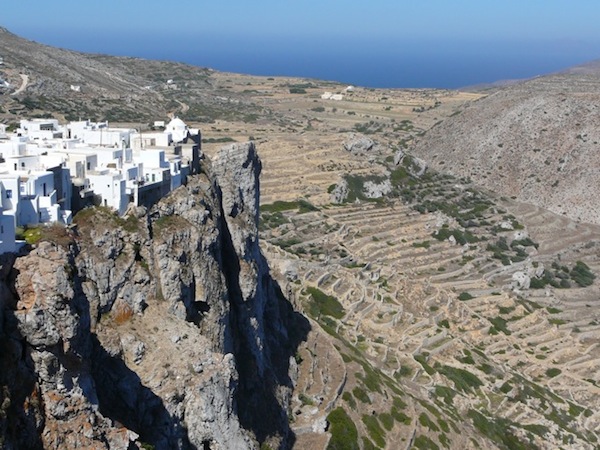
By the time we docked, night had fallen and the gangplank was bucking so violently, I had visions of having to remain on board until Santorini. But we managed to lurch ashore into the welcome van from the Anemomilos Apartments (www.anemomilosapartments.com), which took us up the black mountainside to Hora.
It is always strange to arrive at a new place in the dark. The next day would reveal that we’d driven through a desolate landscape of rocks and spurge (euphorbia) skeletons in which two or three shiny “bungalotels” were trying to create improbably emerald oases. Barren doesn’t begin to describe it. But we saw nothing of that then and, entering the Anemomilos, we found ourselves in a mini Cycladic neighborhood—all white surfaces, tumbling bougainvillea, and paths of green slate, each stone ringed in white. Cheerful, cozy, and wind-free, it could not have been more comforting to us weary, all too venerable, voyagers.
By day, we would see that we were teetering at the very edge of a precipice, with wave-bashed rocks some 210 meters below and, looming above, the fiery face of a mountain that appeared to have been sliced in half. A zigzag path branded like white lightning onto the grey-brown hillside ended at the island’s “cathedral’’—a composition of domes, cubes, and cylinders dedicated to the Virgin. Visible from virtually everywhere, this is the emblem of Folegandros. It lures your eyes and eventually your feet for a closer look.
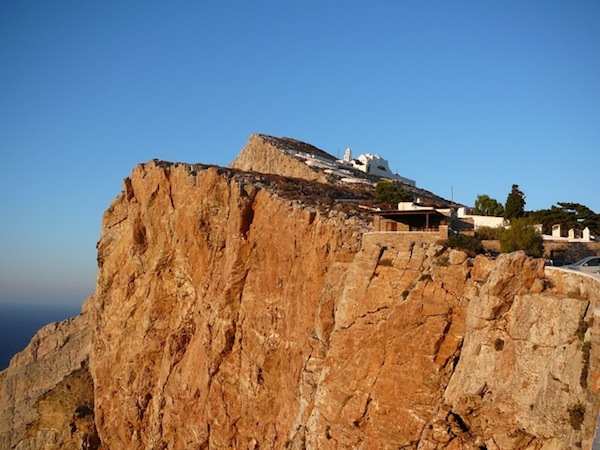
But we resisted its pull until we’d sussed out the town. This did not take long. You can walk from end to end in about ten minutes, well, maybe 15. The Hora starts with a small walled triangle, the Kastro, where the backs of houses formed a defensive barrier to pirate raids. It was built in 1205, after the fall of Constantinople to Venetian-led Catholics who held onto the Aegean for 400 years until routed by the Ottoman Turks. With its narrow lanes flanked by white-washed staircases and wooden balconies in various shades of blue and green, it is a miniature replica of the Kastro of Sifnos.
Outside, the rest of Hora revealed itself as a succession of attractive squares, each presided over by one or more churches and filled with cafés and tavernas but no boutiques. One of them bore the name Dounavis, or Danube, incomprehensible until we read that its two cisterns comprised the island’s main water source and that its residents had a lovely sense of irony. By day, the squares could be stage sets, or classrooms devoted to the principles of Cycladic architecture; their planes, angles, curves, and swirls dazzling white and smooth as yogurt in the sun; inky blue in the shadow. By night, bathed in golden light and vibrating with chatter and clinking forks and glasses, they were transformed into a sequence of effervescent parties.
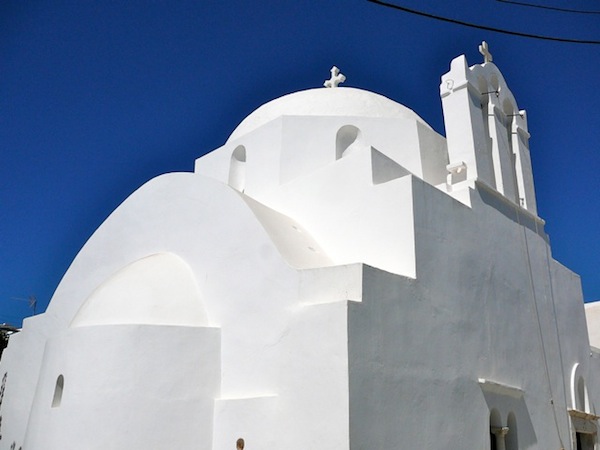
One of the advantages of visiting a small compact place is that it’s so easy to join the party. Folegandros encouraged talk. Any café or taverna we visited more than once greeted us like old friends the second time we showed up. A few journeys on one of the island’s two buses that go either to the port or the most accessible beach, and the driver’s jolly “Yeia sou, ti kaneis?” (Hi, How are you!) warmed our cockles. The sole taxi driver took me back to that beach for free when I discovered my bathing suit had slipped out of my towel. “I was heading there anyway,” he explained.
According to him, the island had 600 permanent inhabitants, 70 kids, and two primary schools. Half the population lives in Hora, the others in Ano or Pano Meria (Upper Place), a strung-out village of farm buildings to the north. Driving there, we wondered at their tenacity. Strips of terracing laddered every precipitous hillside from summit to sea foam, but were empty of cultivation. Even the tomatoes and melons used to surviving without water looked droopy, casualties of a rainless winter. This is the land of the prickly pear and the thorn bush. The wind blasts so relentlessly that each family’s prize lemon tree is wrapped inside its own fortress, a high bastion of stones topped with thorns doubling as barbed wire. The traditional baker kept his oven going not with wood but with thornbush, which seemed in no danger of extinction despite its multiple uses.
This harsh, craggy landscape could not be more different from that of Andros, parts of which are as green as Pelion, as lush as Corfu. But its stern beauty and the effort to tame it captured my heart. Which was further titillated by the beaches. These were not the broad swathes of sand you find on Andros, Mykonos, and Naxos but, rather, enticing turquoise coves nestled between white cliffs or jade rocks. Sometimes they remained eye candy. The meltemi grounded the boat to the northern beaches, appalling roads prevented us venturing to others, even in our rented car, but the translucent sparkle of the water at Angali, Ai Nikolas, and Ambeli more than compensated.
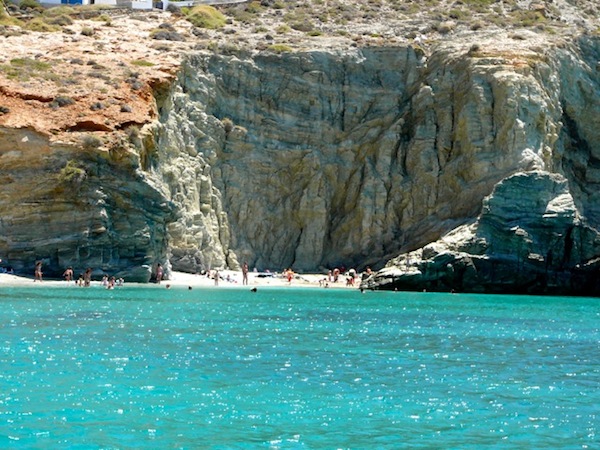
Eating was another pleasure. Uniformly good, the food reached perfection at Mimis’s Taverna in the middle of Ano Meria. Mimis opened it 20 years ago when he left the sea. He grows his own vegetables, his wife turns them into divine concoctions and makes matsata, the local fettucine, with such a light touch you hardly know you’re eating pasta. We sat for hours talking, despite the warning on the wall “not to keep company with a doctor or a priest; the one wants you to hurt, the other wants you to die.” My husband’s confession that he was a surgeon got the conversation off to a fast start.
So many images of Folegandros linger in the memory: the view, from Ano Meria, of ridge-hugging Hora stabbing the sky like a scimitar’s blade and, from the Panayia, of its white houses poised on the brink like lemmings about to jump into the abyss; hawks swooping constantly overhead, living up to their picturesque name of anemogamis or “windf&^%ers”; a donkey standing in a patch of stone, so well camouflaged only its blue bucket betrayed its presence . . . but, most of all, it’s the people I remember. Mitsos offering free rakomelo for our third nightcap in his kafeneion, strangers stopping to chat on the street, making friends on the Anemomilos terrace with other guests and with Dimitris and Lia Patelis, the owners.
Folegandros is so small that you have time to appreciate details and, with so little to do, you get back to what people have always done in the absence of imported entertainment: you tell stories and get to know each other. There are signs that the island’s 60s atmosphere may fade with its popularity and new construction. But, for the moment, it was Greece as I first knew her five decades ago. And well worth the trouble to get there.
But we did take the High Speed Catamaran back to Athens.
![]()
Recipe
Eggless Noodles (from Crete)
I didn’t get the recipe for matsata, the noodles of Folegandros, but here is one from Chania (from my book Feasting and Fasting in Crete). There they sometimes fry half the noodles to make an unusual dish called Mangiri, which they wax very nostalgic about. Anyone who fries leftover spaghetti will like this one.
1/2 kg (1 lb) soft flour
1 teaspoon salt
1 tablespoon lemon juice
2 tablespoons white wine vinegar
60 ml (1/4 cup) olive oil plus olive oil for frying
grated cheese
Sift the flour into a large bowl and make a well in it. Put the salt, lemon juice, olive oil, and vinegar in a jar, screw it tight and shake vigorously for a minute. Pour the contents into the well. With your hands, slowly mix in the flour until you have a well-blended dough. Knead for about 15 minutes, cover, and let rest in a cool place for about 1 hour.
Separate the dough into 10 more or less equal parts and roll out one by one into thin rectangles. Cut each piece into narrow strips 2 cm/ (2/3 inch) wide and then (if you have the patience) into 3 cm (1 inch) squares. Divide the pasta into two.
Fry one half in hot olive oil until crisp and set aside to drain on paper towels. Then boil the other half in 1 1/2-2 litres (6-8 cups) of salted water (this takes only a couple of minutes). Place the boiled pasta in a bowl with a little of its water, top with the fried noodles and some of the frying oil, if desired. Serve with freshly ground pepper and grated cheese. Serves 6.
You can of course make these using a pasta machine. I find they are better if a little thicker than fettucine, so you could stop with the No. 4 setting.
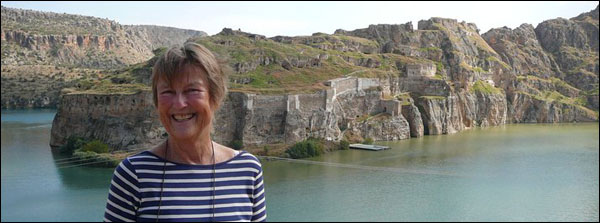

2 Comments
Catharina V Leeuwen
Thank you for this gorgeously delicious story on Folegandros Diana that evoked sweet memories with me.
Your discription of the island and the journey to it is short of identical to my own experiences in the early 70th..
The journey from Pireaus took some 11 hours in good weather and arriving at night was an adventure that was completed by daybreak with the harsh landscapes and stunning views.
I did it many times with my friend Aliki who owns a family property in the little harbour – in those days without electricity and running water.
There was an Athenean fashion designer a few houses along with whom we spend many an evening on his roof terrace with little food but lots of liquids.
avec bisous from Pyrenees Orientale
diana
Catharina, how nice to hear from you. I wish we could have one of those evenings with little food but lots of liquids together on some far off island sometime. How do you find the Pyrenees after Greece? I’d love to hear about your life there. Filia apo Athina.